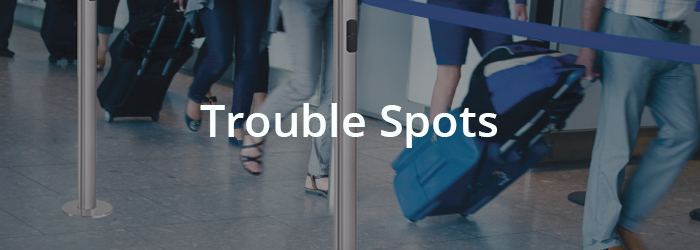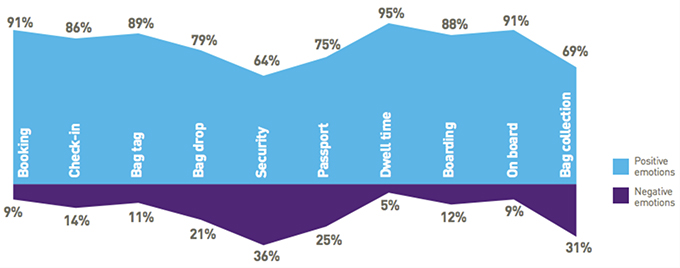
4 Trouble-Spots in the Airport Passenger Experience
The quality of the airport passenger experience has come to the forefront of an industry that is experiencing more competition than ever. Passengers are informed and equipped to make their choice of departure and arrival airports based less on necessity and more on preference. Fail to meet the growing expectations of passengers? Watch your airport brand suffer.
Here are four trouble-spots that tend to cause passengers to reroute their itineraries:
1. Stress at security checkpoints
Security checks serve to increase the level of trust passengers have in an airport (Chen et al. (2015)), but the security screening process is also associated with the highest rate of negative emotions during a passenger’s journey–from booking to bag collection at the arrival airport (SITA, 2016).

A recent AviationFacts.eu report, Airport Security from a Passenger’s Perspective, concluded that the security checkpoint could be a source of competitive advantage to those airports that can optimize the process and the passenger’s feelings of safety. Furthermore, the report found a significant relationship between passenger satisfaction, wait times, and perceived security quality where shorter wait times and better perceived security quality resulted in higher passenger satisfaction.
Airports will find a range of technology- and non-technology-based solutions to drive down wait times and relieve stress at security checkpoints.
2. Wait times throughout airport queues
Just like at security checkpoints, wait times across all airport queues can become a trouble-spot for the passenger experience. Long, unruly waits lead to passenger dissatisfaction while shorter, well-organized waits help improve the overall passenger experience. When you consider the International Airport Transport Association’s prediction that airline travel will rise to nearly 8 billion passengers in 2036, almost double the passengers who flew last year, wait times are a clear concern.
Airports are responding with technology and practices designed to reduce wait times. Today, 88% of airports have self-check-in kiosks and 95% expect to have such kiosks in the next three years, according to SITA’s survey. Add to this, 42% of airports now have wait-time monitoring technology, a jump from 31% in 2017, also according to SITA.
3. Agent productivity
With a rise in airport travel comes rising pressure on airport and airline agents to serve more people, more efficiently. Without the right strategies in place to empower agents to better serve passengers, this can create trouble-spots along the passenger journey.
There are a number of ways airports and airlines can empower agents to be more productive. These include giving them visibility into passenger traffic in the form of real-time footfall analytics. Based on this information, agents can be quickly rerouted to areas where passenger demand is heavy. Automating queuing-related functions is another way to keep agent productivity high. For example, analytics and queuing technologies can be set up to automatically send passengers to areas that have shorter waits; send service agents to areas that have higher demand; allocate service resources in an optimal way; and send alerts to open or close service positions. By automating these tasks, agents are empowered to spend less time routing passengers and more time serving them.
4. Restroom cleanliness
“Bathroom cleanliness is a big driver of satisfaction at airports, and if you want a pleasant experience, clean bathrooms are a must,” said Dimitri Coll, the associate director for the Airports Council International in a recent New York Times article. For its part, DFW airport recently adopted Lavi Industries’ Qtrac iM system to capture passenger feedback on the condition of its restrooms and understand what’s going on in the restrooms as far as usage and cleaning. Real-time facility maintenance technology is helping airports avoid the trouble-spot of poorly-maintained restrooms both in terms of passenger satisfaction and also in terms of resource utilization.
Is your airport environment set up to minimize the trouble-spots and maximize passenger satisfaction? Which of these trouble-spots will you fix next?
SUSCRIBIRSE
Suscríbase para mantenerse al día con los nuevos productos, información y noticias sobre los recursos.
ENTRADAS DE BLOG RECIENTES
Theft at the Register: How Strategic Queue Design Protects Profits
Leer el artículo completoRapid Deployment Crowd Control: JetTrac Portable Barriers For The Biggest Spaces
Leer el artículo completo4 Psychological Reasons Your Customers Hate Waiting In Line
Leer el artículo completoFrom Bleachers To Bookstores: 4 Campus Crowd Control Solutions
Leer el artículo completo








